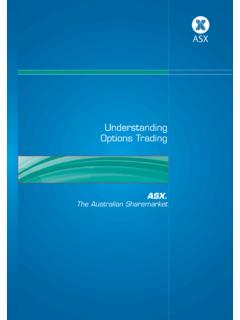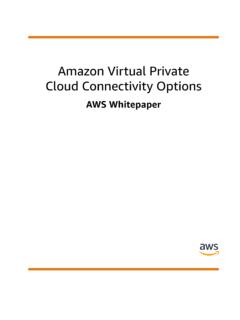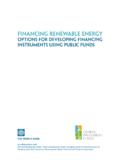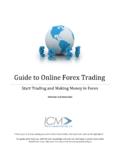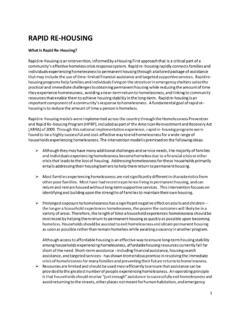Transcription of Options Trading Strategies: Retirement Income from …
1 Options Trading strategies : Retirement Income from Weekly Options Introduction: What You ll Learn in this Guide .. 5 Chapter 1: Option .. 6 Calls and 7 Options Profits and Leverage .. 8,9 Exercising 10 Intrinsic and Time ,11 Bids and Option Expirations .. 11 Options .. 11,12 Settlements ..12,13 Benefits of Weekly 14 1 Important Things to Remember .. 14 Chapter 2 Writing Options .. 12 Covered and Naked Calls .. 15 Why Sell Covered ,16 Naked 17 Important Things to Remember .. 17 Chapter 3 Delta,Vega Gamma, Theta and 18,19 Option Implied Important Things to 21 Chapter 4 Credit Bear Call 22,23 2 Bull Put The Benefits of Credit Spreads.
2 25 Important Things to 25 Chapter 5 Trading Credit Spreads .. 26 Trading Bull Put Trading Bear Call 28 Determining Adequate Lack of Important Things to 25 Chapter 5 Trading Credit Spreads .. 26 Trading Bull Put Trading Bear Call 28 Credit Spread 29 3 How to Choose the Right Credit Spread .. 30 The Delta of the Credit Spread .. 31 The Wideness of the Credit Spread .. 31 Risk Stop Loss and Take Support and Resistance / Trend Lines .. 34 Specific 40 Important Things to Remember .. 40 41 Bollinger Bands, MACD and 41- 43 4 Introduction Options continue to grow at a very sharp pace as investor become aware of their enormous capabilities.
3 With Options , an investor can profit during trending markets as well as sideways markets, and can provide insurance for a portfolio of stocks, commodities and even currencies. This guide will focus on a number of specific Trading strategies , but prior to diving into these strategies , we will discuss calls and puts, which can be either short or long. That is correct, you can have a long call or a short put, a short call or a long put, and by the time you are finished reading this book, it will all make sense to you! Once you have the basics down, we will move on to credit spread strategies , which the best Income producing strategies available. If you are interested in creating a strategy that has defined risk, produces profitable monthly cash flows, while performing well in all market conditions, then credit spreads are the right strategy for you.
4 Every trader should be aware of these types of option Trading strategies , because if you don t, you risk being on the losing side of a game. In fact, historically, 80% of the Options traded settle out of the money. Learning about Options may seem like a daunting task at first. In many ways, it is like learning a new language. Fortunately, once you get a handle on this topic it will make sense. So read on and learn how you too can profit with credit spreads, and earn a safe monthly Income with predetermine risk. 5 Chapter 1: Option Basics Exchange- traded Options , the subject of this guide, are contracts between two individuals: a buyer and a seller.
5 There are Options available for nearly every kind of financial security. There are Options on foreign currencies, commodities, and even more sophisticated financial instruments, such as weather, but this guide will deal exclusively with equity Options , which are Options that give their owner the right to buy or sell shares of a stock at a specific price, on or before a certain date. Options are relatively new products when compared to stocks. Options , in their current form, have only been around since 1973, and they have only gained their current level of popularity recently. For example, in 1999, the volume of Options contracted traded in the stood at around 500 million a year, and by 2013 that number has increased 8 fold. The Options industry notched its second- heaviest volume year in 2013, helped by strong gains in Options tied to benchmark indexes.
6 Trading volumes grew in 2013 to billion contracts, with a total of $ trillion in Options premium exchanging hands throughout the year. Standardization is the key to making Options widely accessible to individual investors. Whereas a real- estate deals for a particular house, is customized, a stock option contract deals with 100 shares of a given stock, for which there are millions exactly alike. 6 Call and Puts In this section we will introduce a number of definitions that will help you become familiar with Options . A call option is a derivative security that gives the option buyer the right but not the obligation to purchase an underlying stock on or before a specific date.
7 A put option is a derivative security that gives the buyer the right but not the obligation to sell or short a stock on or before a specific date. When an option is converted into the underlying stock, it is said to be exercised. The strike price of an option can be defined as the price at which the holder of an option can purchase (in the case of a call option) or sell (in the case of a put option) the underlying stock when the option is exercised. The price of the option or value of the option is referred to as the premium. The date when an option is no longer active is called the expiration date. American style Options ca be exercised on or before the expiration date. European style option can only be exercised on the expiration date a. Option Contracts Options trade in contracts.
8 Each Options contract provides the owner the right to purchase 100 shares of the underlying stock. When an investor purchases one option contract for $1 they are in fact paying for $1 for each share they have the right to purchase. In this case, one contract would cost an investor $100 dollars ($1 * 100 shares). An investor who owns one put contract has the right but not the obligation to sell or short 100 shares of the underlying stock. 7 Option Profits Option prices fluctuate like stocks with market sentiment on daily basis. When the price of the underlying security is above the strike price of a call option, the option is in the money.
9 If the underlying security is below the strike price of a put option the put is in the money . If the underlying price of the security is equal to the strike price of a call or put option, the option is at the money . If an option is under water, the option is to be out of the money . For example if the strike price on a call option for XYZ stock is $25 and the underlying price of XYZ stock is $23, the call option is out of the money . Leverage One of the most apparent advantages of Trading Options is leverage. Leverage is the ability to increase the amount of capital you risk, without having to pony up the funds. As discussed earlier, each option contract controls 100 shares of the underlying stock. The higher the stock price, the more value the option controls. For example, if a trader purchases one call option of Apple, with a strike price of $600, when the price of the stock is $600, the option contract theoretically controls 100 shares * $600 which equates to a notional value of $60,000.
10 Obviously, the owner of a call option would pay a premium for this type of control, but the amount paid is a fraction of the capital that is controlled. 8 The price of an Apple May $600 calls is $ which means that an investor would pay $ * 100 = $124 dollars for the right to purchase 100 shares of Apple at $600 dollars a share. This would allow the investor to use $124 to control $60,000 dollars of Apple stock. As you can see, the leverage is substantial. For every dollar used to purchase the option, a trader controls $484 dollars ($60,000 / $124) The profits can also be substantial when using Options , but when purchasing Options the risk is limited to the premium.

